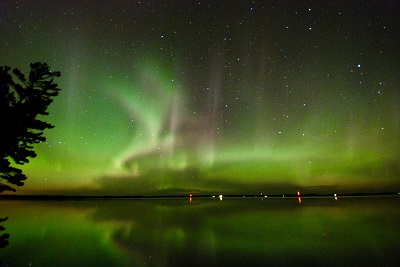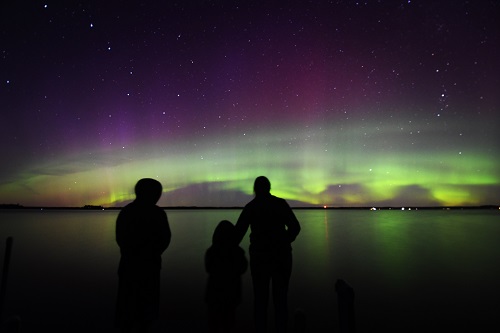Best time to look for Aurora Borealis

Few things in life are as unforgettable as seeing the fabled Aurora Borealis. My first time was in the summer of 2000 when I was a teenager working as a dock boy for a small resort just outside of Voyageurs National Park. At first I didn’t believe my eyes; was I hallucinating? Nope, the sky was clearly full of dancing lights. I was so confused by the swirling colors in the sky that I tracked down my boss, Jeff, and told him that aliens might be breaking into our atmosphere. He laughed. “Didn’t they teach science in your high school?” Confused, I assured him they did.
“Adam, that is the Aurora Borealis or Northern Lights. It is a somewhat rare and very special phenomenon that few people actually get a chance to see. Consider yourself lucky, especially with a show as grand as tonight. Enjoy the display and tomorrow look up northern lights on search.com (there was no google back then!). I think you’ll enjoy what you learn.” Jeff didn’t seem alarmed, so I dismissed my fear and spent the next thirty minutes watching the rippling swirls of light.
The next day I spent hours reading about the auroras. I wanted to know what caused them and why I had never seen them before. Some 23 years later I am very excited for this upcoming season. This year and next will be solar maximum. This means that we will see more auroras than any year in the last 9 or 10 years! Since that summer night as a teenager, I’ve been blessed to see the northern lights at least 100 times. I now subscribe to a website that tracks and predicts the auroras, allowing people like me to enjoy and even photograph the phenomenon. In fact, now at my own resort, I organize an informal photography workshop each week during the latter half of August and all of September on nights when I think we have a good chance to see the northern lights. Unlike my teenage self, I am no longer unnerved by them. Instead I enjoy the sense of awe that each sighting brings.
For those who aren’t familiar with the Aurora Borealis and want to have a chance to see them, here are the basics (and no, it isn’t the reflection of the sun bouncing off the north pole). The sun operates on a cycle usually taking 12-13 years to complete. At the peak of the cycle the sun is fully charged up with energy, and will form sun spots where energy is released into the atmosphere via a CME or coronal mass ejection. This creates a solar wind which carries this energy through space. If the sun spot is facing the earth at the time the CME is hurled into space, the energy will hit our planet within a couple of days. When the energy hits our electromagnetically charged poles, certain elements react atomically with the energy. Namely, certain molecules will become charged up with energy and release their electrons, which in turn re-bond with other similar molecules (this is an extremely simplified explanation of the science behind this-please feel free to research more if you want, it is very interesting!). When the electrons reconnect to the molecules the energy is released as a byproduct. The released energy creates a little bit of light. When enough molecules do this, we enjoy the benefit of this light as a stunning display on dark nights at northern latitudes (it also happens at the south pole).
As a resort operator for the last dozen plus years I’ve had the privilege of helping people see the northern lights from time to time. Pictures I’ve taken of the ethereal display are favorites on our Facebook page and many guests have set up trips just to have a chance to see them. On nights when I think the northern lights will be out, I try to alert guests to the possibility. They often ask what time and how to best see them. Together we plan on making sure all resort lights, including exterior porch lights, are off at dark and then we gather down by our north facing docks with lawn chairs. Often 15-20 people can be found on such an evening sitting along the edge of the lake gazing north, in hopes of seeing something few believe is possible prior to personally experiencing it. Any talk is instantly ended as soon as the first streak lights the sky. The quiet chatter is suddenly replaced by oohs and aahs. No matter how many times I see it, I get goose bumps each time. I’ve come to love sharing this moment with others.
the northern lights from time to time. Pictures I’ve taken of the ethereal display are favorites on our Facebook page and many guests have set up trips just to have a chance to see them. On nights when I think the northern lights will be out, I try to alert guests to the possibility. They often ask what time and how to best see them. Together we plan on making sure all resort lights, including exterior porch lights, are off at dark and then we gather down by our north facing docks with lawn chairs. Often 15-20 people can be found on such an evening sitting along the edge of the lake gazing north, in hopes of seeing something few believe is possible prior to personally experiencing it. Any talk is instantly ended as soon as the first streak lights the sky. The quiet chatter is suddenly replaced by oohs and aahs. No matter how many times I see it, I get goose bumps each time. I’ve come to love sharing this moment with others.
If you would like to see the northern lights, this year is your best chance. The sun is moving into its solar maximum phase of its cycle. This fall should be the peak. If you want to maximize your chances to see the fabled northern lights here is what you need to know.
1. You need complete darkness. Any city lights will either distinguish your chance or at least significantly diminish the grandeur of the celestial show.
2. Know the moon’s schedule. Too many people ask me during a full moon where they can go to see the northern lights. I’m sorry, just like bright city lights, the moon is usually too bright to truly see the northern lights.
3. Best months to see them. I have seen and photographed the northern lights in every month of the year, but if you were to plan a trip to northern Minnesota to see them, there are months where you have better odds of seeing them than others. The best months to see the northern lights are September, October, March and April (not in any particular order). The summer months aren’t great because our days are too long. The winter months are usually too cloudy to see them. We have 4 months of the year that are clear skies the majority of our nights. Mix a good new moon with one of those months and your odds are significantly increased.
4. The fall and spring equinoxes are the highest chances of the year due to the earth’s axis tipping and the resulting shift in magnetic fields above the earth’s poles.
5. The further north you go the better. Yes, there are times when the northern lights are seen in places like Iowa. But that is really rare and takes a huge solar storm. Minor storms are much more likely to cause visible auroras in northern Minnesota.
There are several websites that give out information on solar storms including tracking them and predicting them. My favorite is spaceweather.com. They even have a function where you can subscribe and they will text you when a storm is about to hit our planetary field.
So when is the best time to try? This year is the year for a perfect (solar) storm. We are headed into solar maximum and the September new moon is September 15th. On top of that, this year on the fall equinox (September 21st) the moon will be set in most of Minnesota by 7:45 pm giving us a very dark night. The optimal time for someone wanting to plan to see the northern lights is this year in September from about the 10th thru the 24th. While we won’t have them every night, we should have it every few nights. If you’ve ever heard yourself say, “someday I want to see that” then this is your year. Find a resort in Minnesota that is open in September, faces north, and is far enough away from a city, then book a cabin and you’ll probably see them.
Submitted by Adam Van Tassell
Birch Forest Lodge
Share This Story, Choose Your Platform!